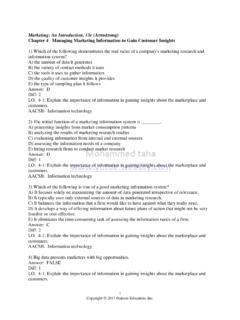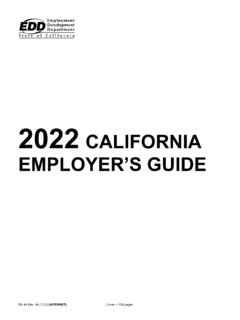Transcription of CHAPTER 5 ACTIVITY-BASED COSTING AND ACTIVITY …
1 EA 5-1 CHAPTER 5 ACTIVITY - based COSTING AND ACTIVITY - based MANAGEMENT 5-1 What is broad averaging, and what consequences can it have on costs? Broad averaging (or peanut-butter COSTING ) describes a COSTING approach that uses broad averages for assigning (or spreading, as in spreading peanut butter) the cost of resources uniformly to cost objects when the individual products or services, in fact, use those resources in non-uniform ways. Broad averaging, by ignoring the variation in the consumption of resources by different cost objects, can lead to inaccurate and misleading cost data, which in turn can negatively impact the marketing and operating decisions made based on that information.
2 5-2 Inaccurate COSTING can result in two deviations. Name the two deviations and explain how they can impact a business. These two deviations are overcosting and undercosting. Undercosting will cause underpricing which can lead to sales that actually result in losses, because the sales may bring in less revenue than the cost of resources, though the company is under the assumption that it is making a profit. Overcosting will lead to overpricing, causing a loss in market share to competitors producing similar products. 5-3 What is COSTING system refinement? Describe three guidelines for refinement. COSTING system refinement means making changes to a simple COSTING system that reduces the use of broad averages for assigning the cost of resources to cost objects and provides better measurement of the costs of overhead resources used by different cost objects.
3 Three guidelines for refinement are 1. Classify as many of the total costs as direct costs as is economically feasible. 2. Expand the number of indirect cost pools until each of these pools is more homogenous. 3. Use the cause-and-effect criterion, when possible, to identify the cost-allocation base for each indirect-cost pool. 5-4 What are the fundamental cost objects in ACTIVITY - based COSTING ? How does ACTIVITY - based COSTING work? Individual activities are the fundamental cost objects in ACTIVITY - based COSTING . ACTIVITY - based COSTING first uses resource drivers to assign the costs of resources to individual activities and then it uses ACTIVITY drivers to assign the cost of these activities to products or services (as final cost objects).
4 5-5 How can a cost hierarchy lead to a more accurate COSTING system? A cost hierarchy can lead to a more accurate COSTING system by focusing on the levels of cause-and-effect relationships between various ACTIVITY cost pools on the one hand and final cost objects on the other hand. It categorizes various ACTIVITY cost pools into four individual levels on the basis of the different types of cost drivers, cost-allocation bases, or the different degrees of difficulty in determining cause-and-effect relationships. These four levels of a cost hierarchy EA 5-2 (from the highest to the lowest cause-and-effect relationship to cost objects) are: output unit-level costs, batch-level costs, product-sustaining costs or service-sustaining costs, and facility-sustaining costs.
5 5-6 Which levels of cost hierarchy (under ACTIVITY - based COSTING ) are not used in simple COSTING systems and why are they important? Out of four levels of hierarchy costs in ACTIVITY - based COSTING , only output unit-level costs is used in simple COSTING systems. In other words, there are three additional levels of hierarchy costs in ACTIVITY - based - COSTING systems which are not used in simple COSTING systems as follows: batch-level costs, product-sustaining costs or service-sustaining costs, and facility-sustaining costs. These three additional levels of hierarchy costs are important because not all cost-allocation bases are unit level. Some are batch-level costs, some are product-sustaining costs and some are facility-sustaining costs which have no direct link with the cost objects.
6 5-7 Differentiate between simple COSTING systems and ABC systems. The main difference between simple COSTING systems and ABC systems is due to having different focuses. Activities are the fundamental cost objects in ABC systems, while departments, centers or cost pools are the main fundamental cost objects in simple COSTING systems. Simple COSTING systems have one or a few indirect cost pools, irrespective of the heterogeneity in the facility while ABC systems have multiple indirect cost pools. Under ABS systems, the costs of activities are assigned to cost objects to compute their costs. Under simple COSTING systems, the costs of departments, centers or cost pools are assigned to cost objects to compute their costs.
7 5-8 How can ABC help with cost reduction and process improvement decisions? ABC can help with cost reduction and process improvement decisions by identifying individual activities and their relevant costs. This can help managers to eliminate non-added value activities, reduce costs and improve the overall process. 5-9 The cost of cost objects under simple COSTING systems and under ACTIVITY - based COSTING are never the same. Do you agree? Explain. No. It depends on a number of factors such as the variety and number of activities, cost allocation bases, and cost objects/products. For example: if a company produces one single product then the product cost under both simple COSTING systems and ACTIVITY - based - COSTING can be the same.
8 Or, when different products use resources from different activities in the same proportions as with simple COSTING systems. 5-10 Describe the main barriers for adopting an ABC system. The main restrictions towards adopting an ABC system include the need to use more resources ( , experts and software packages) as well as the requirement for gathering additional data/information and performing more measurements to implement it. One of the main complications of ABC is that it requires managers to estimate costs of ACTIVITY pools in order to identify and measure cost drivers for specified cost pools to be used as cost-allocation bases. It needs many calculations to determine costs of cost objects and these measurements are EA 5-3 expensive.
9 It needs to be updated regularly. As ABC systems get very detailed and more cost pools are created, more allocations are needed to calculate ACTIVITY costs for each cost pool, and this could increases the chances of misidentifying the costs of different ACTIVITY cost pools. Sometimes the data needed for the relevant allocation base is not readily available. 5-11 What are the main behavioral issues in implementing ABC systems? Gaining support of top management and creating a sense of urgency for the ABC effort. Creating a guiding coalition of managers throughout the value chain for the ABC effort. Educating and training employees in ABC as a basis for employee empowerment.
10 Seeking small short-run successes as proof that the ABC implementation is yielding results. Recognizing that ABC information is not perfect because it balances the need for better information against the costs of creating a complex system that few managers and employees can understand. 5-12 Explain why ABC is equally important for both manufacturing and service companies. ABC systems can be used equally for product COSTING and service COSTING as well as for strategic decisions in manufacturing and service companies. ABC systems are more suited to service companies because a vast majority of their cost structure is composed of indirect costs. 5-13 ACTIVITY - based COSTING is providing more accurate and detailed information and should replace simple COSTING .















